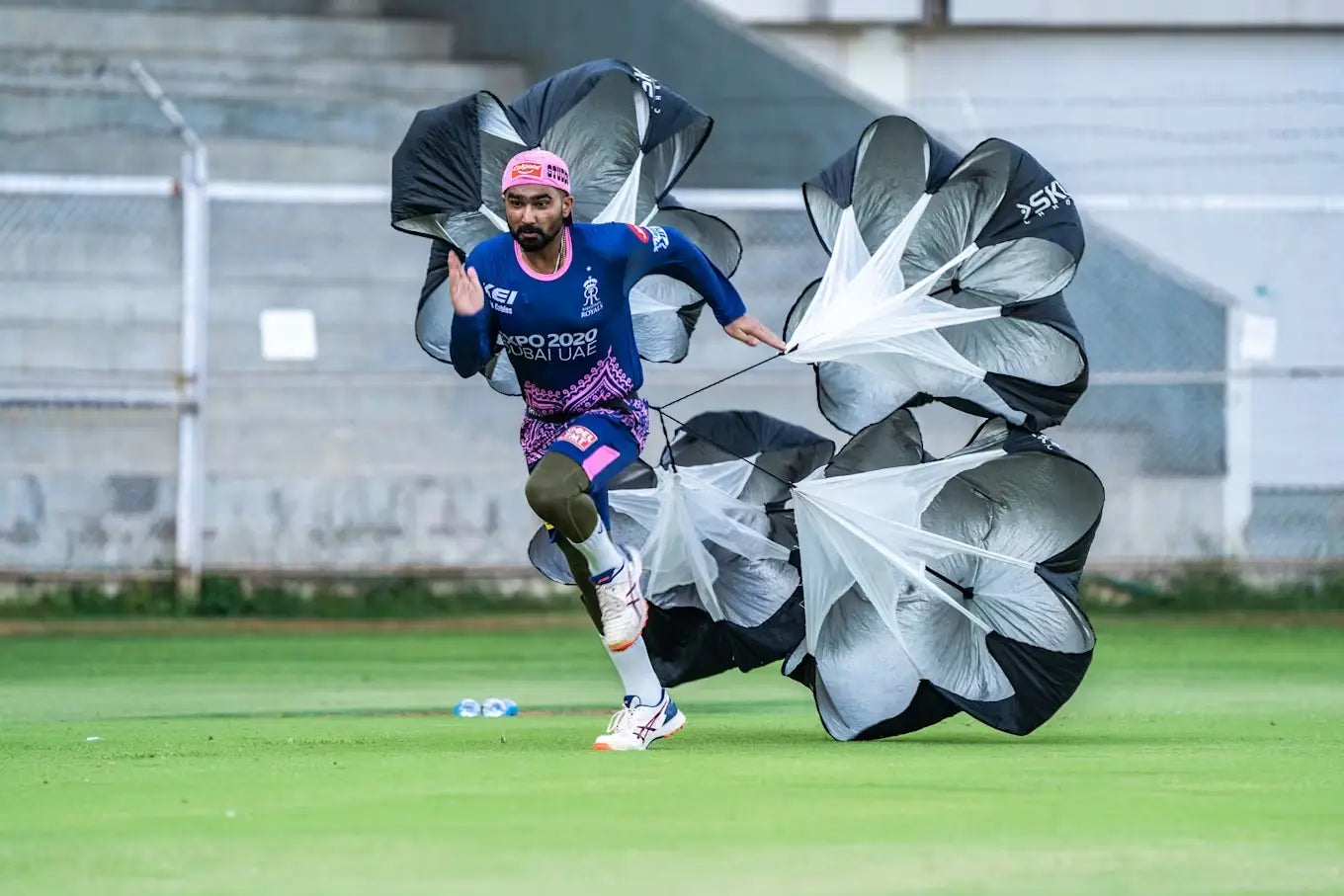Cricket is a sport that demands fitness in every aspect. Whether it be running 20 meters to stop a boundary or making that essential dive to be safe from a close run out. But one aspect of cricket is such that it needs more hard work, dedication, and fitness levels than anything else. You could have the best talent in the world with the leather ball, the right bowling technique, the perfect action, the right jump, and the best seam position, but there’s something more important than keeping yourself fit and remaining injury free. There have been some supremely talented fast bowlers, who could have become legends if not for their cricket injuries. There are various examples of this, Bhuvaneshwar Kumar who has been India’s best swing bowler in the past decade, and Shaheen Afridi, Pakistan's rising talent and T20I captain, both have missed important matches due to injuries. Not only this, fast bowling requires proper technique and your body to have the right strength to bowl quickly and trouble the batsman.

Credit: Telegraph India
So, here’s a comprehensive Gym Workouts and Exercises for fast bowling article by ZAP, that will help not only take your bowling a notch up but also help you enjoy an injury free career.
Cricket Fast Bowling Warm-Up and Exercises:
Agility, Stamina and Explosivity is a must for all fast bowlers. Having an agile body will help you stay tough against injuries and enjoy a prolonged duration before there’s any sign of discomfort. In test matches, bowlers usually have to bowl for 8-10 bowlers on the trot without dropping any intensity. That’s the reason you need stamina to bowl overs without dropping a drop of sweat. And explosivity to delivery those rapid deliveries that reach the batsman in a flash. Explosivity can be built by having strong legs, massive shoulders, and a strong core.

Credit: ESPN Cricinfo
Fast bowling is all about running. Running large distances and sprinting are essential for developing endurance and speed in a fast bowler. 90% of fast bowling is running. Since the 1930s, when strength training and conditioning for athletes was still in its early days, bowlers have been able to hit speeds of over 90 mph by just running a lot and developing strong legs. Running is a full-body exercise. It strengthens your core as well as your leg muscles. Despite not being very jacked with muscles, Michael Holding, Jeff Thomson (one of the fastest bowlers of all time), and other in the 70s and 80s bowled long spells at lightning speeds. What they did can be attributed to the fact that all of them were very good runners.
Sprint Training:
Include short sprints of 20-30 meters in your training routine to improve your explosiveness off the mark, which is crucial for fast bowlers.
Also add a routine of parachute sprints by attaching a parachute behind your back which adds resistance and builds fuctional power to generate faster acceleration.
Banded Running:
Fix one end of a resistance band around your body and the other end to an anchor point. No performs sets of sprints starting from the anchor point away from it. This drill will help you build strength and endurance in your hip and leg muscles.
Agility Drills:

Credit: Healthline
Set up cones, hurdles or markers and perform agility drills to enhance your footwork and coordination. This is essential for maintaining balance and control during your bowling action.
Plank:
The plank is an excellent exercise for pacers. This exercise doesn't need any special equipment and can be done pretty much anywhere. Planks are essential for developing core strength and preventing lower back injuries, which are particularly common among fast bowlers.
Plyometrics:
Plyometrics are a valuable component of a fast bowler’s training regime. Plyometric exercises focus on explosive movements, which can contribute to improved power, strength, and overall athletic performance. Here's how plyometrics can benefit bowlers in cricket:
Leg Strength and Conditioning:
Drills like Box Jumps and Alternate Jump Lunges are effective in building leg strength and conditioning. For bowlers, strong and conditioned legs are crucial for generating power in the delivery stride and bowling action. This power can translate into greater bowling speed and accuracy.
Soft Landing Emphasis:
Jumping Over Obstacles with Soft Landings can help bowlers to increase strength and protect their joints. Maintaining joint health is crucial for sustaining a long and successful bowling career. Plyometric exercises that incorporate soft landings help develop the necessary strength without putting undue stress on the joints and muscles.
Integration into Overall Training Plan:
Plyometrics should be integrated into a well-rounded training plan that includes strength, speed, endurance, mobility, and power training. Focusing solely on plyometrics or any single method may not provide comprehensive benefits. A holistic training approach ensures that a cricketer, especially a bowler, develops a well-rounded skill set and minimizes the risk of overuse injuries.
Also Read: Two Important Skills as a pacer:
How to bowl inswing, outswing and reverse swing | Fast Bowling Variations
Gym Workouts for Fast Bowlers:
To be the best, you have to train like the best. Fast Bowling is all about putting in those extra hours lifting weights in the gym to strengthen your muscles and refine your technique. Sweating it out in the gym efficiently will help you gain strength in your legs, core, and shoulder, the three most important body parts for an effective fast bowling technique.
Fast Bowling Leg Exercises:
Squats:

Credit: Men's Health
Squats are a compound exercise that works multiple muscle groups in the legs, including the quads, hamstrings, glutes, and calves. These muscles are all important for generating power and explosiveness when bowling.
Lunges:

Credit: Dmoose
Lunges are another compound exercise that works the quads, hamstrings, and glutes. They also help to improve balance and coordination, which are important for maintaining a stable bowling platform.
Box Jumps:

Credit: Physio Perfomance
Box jumps are a plyometric exercise that helps to improve power and explosiveness. They help to develop the quick-twitch muscle fibers that are important for fast bowling.
Calf Raises:

Credit: GQ
Calf raises are an isolation exercise that works the calf muscles. Calf raises are important for ankle stability and explosiveness, which are important for generating power when bowling.
Leg Press:
Leg press is a machine exercise that works the quads, hamstrings, and glutes. It is a good exercise for isolated leg strength training.
Fast Bowling Gym Shoulder Exercises:
Barbell Overhead Press:

Credit: Coach
The barbell overhead press is a compound exercise that works the entire shoulder, including the anterior, medial, and posterior deltoids, as well as the traps. These muscles are all important for generating power and explosiveness for rotating your arm when bowling and increasing speed. Also, bigger and stronger shoulders mean a stronger and quicker throws from the boundary to the pitch.
Lateral Raises:

Credit: Muscle and Fitness
Lateral raises are an isolation exercise that works the side shoulder muscles (medial deltoids). This muscle is important for shoulder stability and strength, which are important for maintaining a consistent bowling action.
Landmine Presses:

Credit: Men's Health
The Landmine press is a workout which exactly imitates your bowling action motion and will help you develop the shoulder strength to bowl faster and get that extra pace and zip in your deliveries.
Fast Bowling Gym Core Workouts:
Plank:

Credit: Men's Health
Plank is an isometric exercise that works the entire core, including the abdominals, obliques, and lower back. A strong core is important for maintaining a stable bowling form and preventing injuries.
Side Plank:
Side plank is a workout that works the obliques. The obliques are important for generating rotational power when bowling.
Russian Twists:
Russian twists are a dynamic exercise that works the entire core, including the abdominals, obliques, and lower back. They also help to improve rotational power and coordination.
FAQ:
What should a fast bowler do in gym?
A pacer should focus on developing his leg strength by doing squats and lunges for a better run up and jump, core strength by doing planks, side planks and russian twists and and the shoulder strength for increasing pace by doing dumbbell press, landmine press and lateral raises.
How can I increase my bowling speed at the gym?
By following the right training regime for creating strength in the three main body parts, the legs, the shoulders and the core and by practising bowling quick in the nets, you can start delivering balls faster.
How do you build muscle for fast bowling?
You should follow a proper training routine, train for 3-4 days a week, training more wont give you better results. Keep some time off for your recovery and rest which is very important for all athletes. Also, following a proper diet is a must for all athletes.
Now that you have learn't about fast bowling gym workout and exercises, here are some more skills that you should to master the sport:
Batting Tips and Techniques | Power Hitting - How to Hit Big Sixes | Spin Bowling Tips and Techniques | Wicket Keeping Techniques | Fielding Tips and Techniques



Share:
Ranking the Best All Rounders in Cricket History
Yo-Yo Test in Cricket: The Ultimate Fitness Challenge
8 comments
Does farmer’s carry,cable woodchoppers,bulgarian Squats help better,or what touch have told is enough
Fast bowler gym plan
Fast bowler body workouts
First bowler body workout
It’s help me more